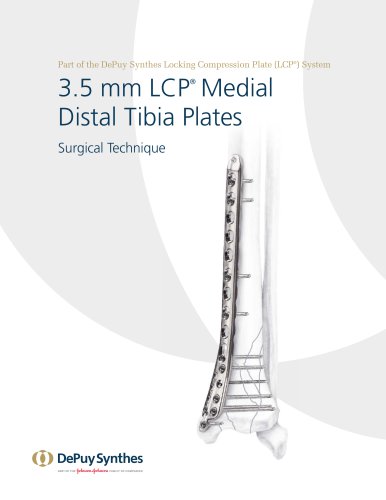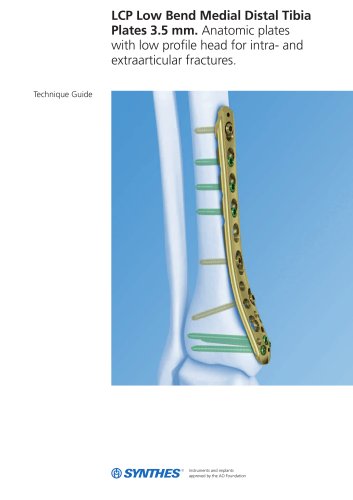
Catalog excerpts

DHS Blade. For osteoporotic bone. Technique Guide ^^^^MOriginal Instruments and Implants of the Association O MMWM llCO for the Study of Internal Fixation-AO ASIF
Open the catalog to page 1
Introduction Features and Benefits 2 Surgical Technique Implantation 6 Product Information DHS Blade 15 O Image intensifier control This description is not sufficient for immediate application of the instrumentation. Instruction by a surgeon experienced in handling this instrumentation is highly recommended.
Open the catalog to page 3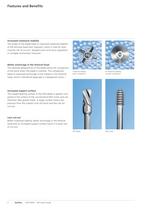
0X6.000.686_AA.qxp:0X6.000.686_AA 10.12.2008 7:55 Uhr Seite 2 Features and Benefits Increased rotational stability The shape of the blade leads to improved rotational stability of the femoral head-neck fragment, which is vital for reducing the risk of cut-out, delayed union and varus angulation in unstable trochanteric fractures. 1 Better anchorage in the femoral head The specially designed tip of the blade allows for compaction of the bone when the blade is inserted. This compaction leads to improved anchorage of the implant in the femoral head, which is beneficial especially in...
Open the catalog to page 4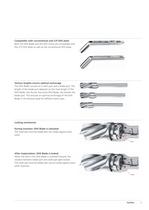
0X6.000.686_AA.qxp:0X6.000.686_AA 10.12.2008 7:55 Uhr Seite 3 Compatible with conventional and LCP DHS plate Both the DHS Blade and the DHS Screw are compatible with the LCP DHS plate as well as the conventional DHS plate. Various lengths ensure optimal anchorage The DHS Blade consists of a shaft part and a blade part. The length of the blade part depends on the total length of the DHS Blade: the shorter the entire DHS Blade, the shorter the blade part. This ensures an optimal anchorage of the DHS Blade in the femoral head for different bone sizes. Locking mechanism During insertion: DHS...
Open the catalog to page 5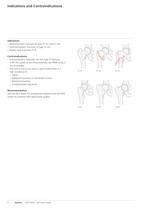
0X6.000.686_AA.qxp:0X6.000.686_AA 10.12.2008 7:55 Uhr Seite 4 Indications and Contraindications Indications – Pertrochanteric fractures of type 31-A1 and 31-A2 – Intertrochanteric fractures of type 31-A3 – Basilar neck fractures 31-B Contraindications – Subtrochanteric fractures: for this type of fracture, a 95º DCS plate or the intramedullary nail PFNA Long is recommended. – The DHS is not to be used in cases where there is a high incidence of: – Sepsis – Malignant primary or metastatic tumors – Material sensitivity – Compromised vascularity 31-A1 31-A2 31-A3 31-B1 31-B2 31-B3...
Open the catalog to page 6
0X6.000.686_AA.qxp:0X6.000.686_AA 10.12.2008 7:55 Uhr Seite 5 Clinical Cases Pertrochanteric fractures Special surgical considerations: Implant of choice Recent metanalysis has shown that the DHS tends to be statistically superior to intramedullary devices for trochanteric fractures.3,4 Further studies are required to determine whether different types of intramedullary nails produce similar results, or whether intramedullary nails are advantageous for certain fracture types (e.g. subtrochanteric fractures).4 Prevention of cut-out: correct placement of the screw The correct placement of the...
Open the catalog to page 7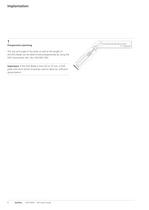
0X6.000.686_AA.qxp:0X6.000.686_AA 10.12.2008 7:55 Uhr Implantation 1 Preoperative planning The size and angle of the plate as well as the length of the DHS Blade can be determined preoperatively by using the DHS Goniometer (Art. No. 034.000.185). Important: If the DHS Blade is from 65 to 75 mm, a DHS plate with short barrel should be used to allow for sufficient dynamization. 6 Synthes DHS Blade Technique Guide Seite 6
Open the catalog to page 8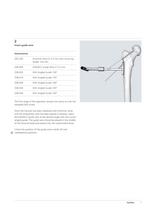
Insert guide wire 292.200 Kirschner Wire 0 2.0 mm with trocar tip, 338.000 DHS/DCS Guide Wire 0 2.5 mm The first stage of the operation remains the same as with the Once the fracture has been stabilized with Kirschner wires and the anteversion wire has been placed in position, place the DHS/DCS guide wire at the desired angle with the correct angled guide. The guide wire should be placed in the middle of the femoral head and extend into the subchondral bone. Check the position of the guide wire in both AP and
Open the catalog to page 9
0X6.000.686_AA.qxp:0X6.000.686_AA 10.12.2008 7:55 Uhr Implantation 3 Determine length of DHS Blade Instrument 338.050 DHS/DCS Direct Measuring Device Read the length of the DHS Blade directly off the guide wire with the measuring device. If the guide wire is inserted into the subchondral bone, remove 5 mm from the measurement. Example: If you read 105 mm on the direct measuring device, the measured length of the implant is 100 mm. 4 Drill for insertion of DHS Blade Instruments 03.224.009 Triple Reamer for DHS Blade, complete Consisting of: 03.224.003 Drill Bit л 6.0/10.5 mm 338.110 DHS...
Open the catalog to page 10
0X6.000.686_AA.qxp:0X6.000.686_AA 10.12.2008 7:55 Uhr Seite 9 5 Insert DHS Blade Instruments 03.224.001 Insertion Instrument for DHS Blade 03.224.007 Connecting Screw for Insertion of DHS Blade 338.320 DHS/DCS Centering Sleeve Insert the connecting screw into the insertion instrument. Slide the appropriate DHS plate onto the insertion instrument and connect the DHS Blade to the insertion instrument. Warning: Be sure that the DHS Blade is unlocked before you insert it. Mount the centering sleeve onto the insertion instrument and insert the DHS Blade with slight hammering. If excessive...
Open the catalog to page 11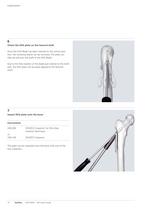
0X6.000.686_AA.qxp:0X6.000.686_AA 10.12.2008 7:55 Uhr Implantation 6 Orient the DHS plate on the femoral shaft Once the DHS Blade has been inserted to the correct position, the centering sleeve can be removed. The plate can then be slid over the shaft of the DHS Blade. Due to the free rotation of the blade part relative to the shaft part, the DHS plate can be easily aligned to the femoral shaft. 7 Impact DHS plate onto the bone Instruments 338.280 or 338.140 DHS/DCS Impactor, for One-Step Insertion Technique DHS/DCS Impactor The plate can be impacted onto the bone with one of the two...
Open the catalog to page 12
0X6.000.686_AA.qxp:0X6.000.686_AA 10.12.2008 7:55 Uhr Seite 11 8 Fix the DHS plate onto the shaft Remove all the insertion instruments and the guide wire. Then fix the plate to the femoral shaft. A Cortex screws for the conventional DHS plate Instruments 323.460 Universal Drill Guide 4.5 /3.2 310.310 Drill Bit л 3.2 mm 319.010 Depth Gauge 314.150 Screwdriver Shaft, hexagonal Use the drill guide and the drill bit to drill holes in a neutral position through the plate holes. Insert self-tapping 4.5 mm cortex screws of appropriate length. Synthes 11
Open the catalog to page 13All Depuy Synthes catalogs and technical brochures
-
2.0 mm LCP® Distal Ulna Plate
20 Pages
-
Building on Success
16 Pages
-
RADIUS OF CURVATURE
3 Pages
-
Introducing The Variable Angle
12 Pages
-
HEALIX Anchor™ 3.4 mm
2 Pages
-
Small Battery Drive II
4 Pages
-
HEALIX ADVANCE
4 Pages
-
3.5 mm LCP™ Medial
15 Pages
-
Titanium Sternal Fixation System
34 Pages
-
MatrixRIB®FixationSystem
86 Pages
Archived catalogs
-
2.4 mm VA LCP™
4 Pages
-
Mandible Trauma Solutions
2 Pages
-
Power line II
4 Pages
-
Concorde
28 Pages
-
LCP Intercarpal
31 Pages
-
LCS® COMPLETE™
2 Pages
-
Synthes TPLO.
8 Pages
-
SynFix-LR System
56 Pages
-
ATB Anterior Tension Band Plate
32 Pages
-
CONDUIT™
15 Pages
-
Brochure_FINAL
2 Pages
-
DePuy Synthes
81 Pages
-
Anspach
3 Pages
-
Orthopedic Foot Instruments
32 Pages
-
PINNACLE® Hip Solutions
12 Pages
-
Corail
24 Pages
-
S-ROM® NOILES™
68 Pages
-
TRI-LOCK® Product Rationale
12 Pages
-
Reclaim Surgical Technique
44 Pages
-
Speed
2 Pages
-
attune
80 Pages
-
HAMMERLOCK® 2
2 Pages
-
DePuy Glenoid Solutions
2 Pages
-
Trauma Solutions. Elbow
4 Pages
-
Polar
4 Pages
-
Alveolar Distractor.
4 Pages
-
Piezoelectric System
4 Pages
-
Air Power Line II
6 Pages
-
LCP Clavicle Hook Plate
4 Pages
-
TruMatch Pin Guides
16 Pages
-
P F N A
8 Pages
-
SKILL, DEDICATION,
16 Pages
-
Orthopaedics. Overview
20 Pages
-
DURALOC
16 Pages
-
Marathon Cemented Cup
20 Pages
-
REEF Surgical Technique
16 Pages
-
MatrixNEURO
8 Pages
-
Anspach XMax
4 Pages
-
Anspach eMax 2 Plus
4 Pages
-
Small Electric Drive
4 Pages
-
Air Pen Drive
4 Pages
-
Colibri II
4 Pages
-
Spine
25 Pages
-
Expert Hindfoot Arthrodesis Nail
48 Pages
-
LCP Distal Fibula Plates
32 Pages
-
TomoFix
60 Pages
-
Expert Tibial Nail PROtect
16 Pages
-
Expert Tibia Nail
84 Pages
-
Sacral Bars
16 Pages
-
Pelvic C-Clamp
20 Pages
-
Low Profile Pelvic System
16 Pages
-
Proximal Femoral (Hook) Plate
24 Pages
-
PFNA
112 Pages
-
HCS 1.5, 2.4, 3.0
36 Pages
-
LCP Wrist Fusion
32 Pages
-
LCP Compact Hand
28 Pages
-
VA-LCP Elbow
48 Pages
-
Distal Radius
44 Pages
-
Olecranon
30 Pages
-
LCP Hook Plate
28 Pages
-
DHP & Olecranon
4 Pages
-
LCP S-A
4 Pages
-
Epoca
4 Pages
-
Philos
32 Pages
-
MultiLoc
68 Pages










